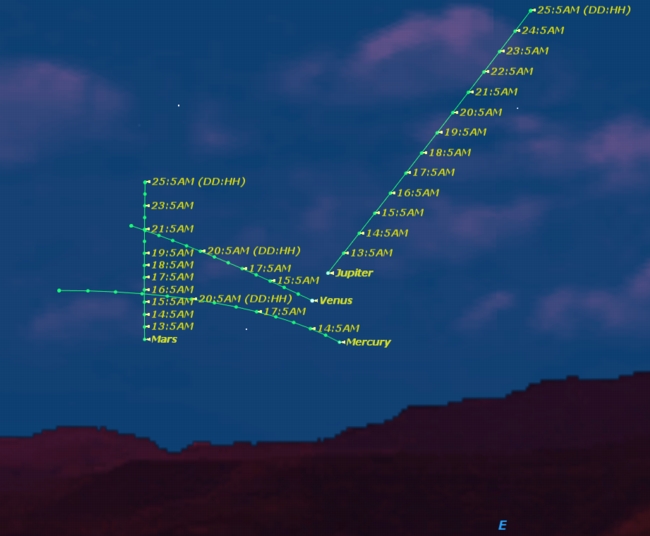Four Planets Now Performing Sky Dance at Dawn

If you look closely at the eastern horizon just before sunrise for the next two weeks, you should notice the bright planets Venus and Jupiter. Look closer still, perhaps with the help of binoculars, and you should spot two more planets, Mercury and Mars.
If you follow the four planets from one morning to the next, you should see some remarkable changes in their positions, as indicated on the sky map of the planets available here.
In the chart, the planet dance performers for tomorrow morning (May 12) are marked by their names: Mercury, Venus, Mars, and Jupiter. The tracks in the sky map indicate the day-by-day changes in the positions. [Video: Moon and Planet Alignments through June]
Dance of the planets
As you can see, three planets begin the two-week stretch in a tight triangle: brilliant Venus and Jupiter above, fainter Mercury below. Mars is way off to the left. Jupiter behaves as you would expect of a normal morning object, moving higher and farther to the right each morning.
Mercury and Venus are both on the far side of the sun and are moving rapidly with retrograde motion toward their next superior conjunctions with the sun, on June 13 and Aug. 16, respectively, so seem to move from right to left. Mars is just past conjunction with the sun and is mainly moving straight upward from the horizon.
Close encounters of the planet kind
Get the Space.com Newsletter
Breaking space news, the latest updates on rocket launches, skywatching events and more!
Because of the different tracks each of the planets is following, they will all experience "close encounters" with one another over the next two weeks.
Mercury and Jupiter were closest yesterday morning (Tuesday May 10). Venus and Jupiter were closest this morning (May 11).
Mercury and Venus are moving parallel to each other, and will be closest next Wednesday, May 18. Mercury and Venus will then pass close to Mars on Friday, May 20, and Sunday, May 22, respectively.
Remember that, even though planets may appear close in the sky, this is an effect of perspective. In reality they are all spread over a line nearly six times longer than the distance from the Earth to the sun. The average distance between the Earth and sun is about 93 million miles (150 million kilometers).
Use the sky map to tell what's what as the four "morning stars" dance at dawn.
If you snap photos of the planetary dance by Mercury, Venus, Jupiter and Mars and would like to share it with SPACE.com for a possible story or gallery, contact managing editor Tariq Malik at: tmalik[at]space.com.
This article was provided to SPACE.com by Starry Night Education, the leader in space science curriculum solutions. Follow Starry Night on Twitter @StarryNightEdu.
Join our Space Forums to keep talking space on the latest missions, night sky and more! And if you have a news tip, correction or comment, let us know at: community@space.com.

Geoff Gaherty was Space.com's Night Sky columnist and in partnership with Starry Night software and a dedicated amateur astronomer who sought to share the wonders of the night sky with the world. Based in Canada, Geoff studied mathematics and physics at McGill University and earned a Ph.D. in anthropology from the University of Toronto, all while pursuing a passion for the night sky and serving as an astronomy communicator. He credited a partial solar eclipse observed in 1946 (at age 5) and his 1957 sighting of the Comet Arend-Roland as a teenager for sparking his interest in amateur astronomy. In 2008, Geoff won the Chant Medal from the Royal Astronomical Society of Canada, an award given to a Canadian amateur astronomer in recognition of their lifetime achievements. Sadly, Geoff passed away July 7, 2016 due to complications from a kidney transplant, but his legacy continues at Starry Night.










